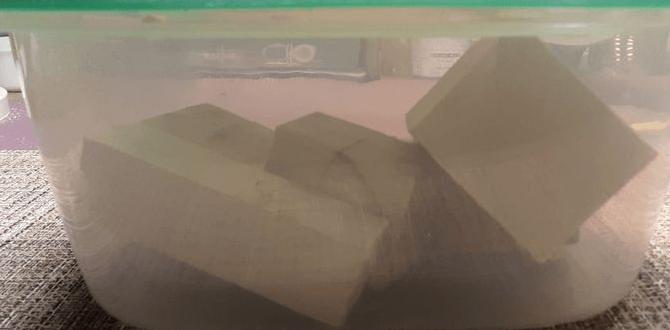A regular maintenance schedule for your nailer keeps it running smoothly, prevents frustrating jams, and extends its lifespan. Simple, consistent care ensures your tool is always ready for your next project, saving you time and money in the long run. Follow these essential tips for optimal nailer performance.
Hey there, fellow woodworkers and DIYers! Jack Shaffer here, your go-to guy for all things nailers and tools. Ever found yourself mid-project, only for your trusty nailer to sputter, jam, or just plain quit? It’s a common frustration, right? That’s usually a sign it’s time for a little TLC. Keeping your nailer in top shape doesn’t have to be complicated. With a good maintenance plan, you can avoid those project-halting hiccups and ensure your nailer serves you reliably for years to come. We’ll walk through a simple, effective maintenance schedule designed for everyone from the weekend warrior to the seasoned hobbyist. Get ready to give your nailer the care it deserves!
Table of Contents
Why a Nailer Maintenance Schedule is Crucial
Think of your nailer like any other hardworking tool in your workshop. Just as a car needs regular oil changes and a saw blade needs sharpening, your nailer requires consistent attention to perform at its best. Neglecting maintenance can lead to a cascade of problems:
- Jams and Misfires: The most common culprit for a jammed nailer is often a buildup of dust, debris, or old lubricant. This can prevent the driver blade from moving freely or the magazine from feeding nails correctly.
- Reduced Power and Accuracy: A dirty or poorly lubricated nailer won’t drive nails with the same force. This means nails might not sink fully, or they might go in crooked, compromising the integrity of your work.
- Premature Wear and Tear: If parts aren’t clean and properly lubricated, they rub against each other dry. This friction causes premature wear, shortening the lifespan of your nailer and potentially leading to costly repairs.
- Safety Hazards: A malfunctioning nailer can be dangerous. A jammed mechanism or a weak firing action could cause unexpected behavior, increasing the risk of accidental discharge or injury.
- Voided Warranties: Many manufacturers require proof of regular maintenance to honor their warranties. Skipping maintenance could mean you’re on the hook for repairs that would otherwise be covered.
Implementing a simple maintenance schedule is the best way to keep your nailer firing accurately, reliably, and safely. It’s about proactive care, not reactive fixes.
Understanding Your Nailer Type
Before we dive into the schedule, it’s important to remember that different types of nailers have slightly different needs. The core principles of cleaning and lubrication apply to all, but some specific steps might vary. Let’s look at the most common types:
- Pneumatic (Air) Nailers: These are powered by compressed air from an air compressor. They are powerful and common in professional settings. They require regular oiling (for some models) and care for the air lines and compressor.
- Electric Nailers: These plug into a standard outlet. They are convenient but can sometimes be less powerful than pneumatic models. Maintenance often focuses on cleaning the drive mechanism and ventilation.
- Cordless (Battery) Nailers: These use rechargeable batteries. They offer portability and ease of use. Maintenance involves keeping the battery contacts clean and ensuring the drive system is free of debris.
- Gas-Powered Nailers: These use fuel cells and batteries. They are also very portable but require specific maintenance related to the fuel delivery system and spark plug.
Always refer to your specific nailer’s owner’s manual for detailed instructions tailored to its design. Some manuals can be found online on the manufacturer’s website if you’ve lost yours.
Your Essential Nailer Maintenance Schedule
Consistency is key! Here’s a breakdown of a maintenance schedule you can easily follow. We’ll organize it by frequency: after every use, monthly, and annually. This keeps things manageable and ensures your nailer is always in good working order.
1. Maintenance After Every Use
These are quick checks and clear-ups that take just a minute or two but make a big difference. Make them a habit!
- Disconnect Power: Crucially, always disconnect the power source before performing any maintenance. For pneumatic nailers, this means disconnecting the air hose. For electric or cordless models, unplug them or remove the battery.
- Clear Debris: Give the exterior of your nailer a quick wipe-down. Brush away any sawdust, wood chips, or other debris that might have accumulated. Pay attention to the air exhaust port (if applicable) and the area around the nosepiece.
- Check the Magazine: Ensure the nail magazine is clear of any bent nails, debris, or obstructions that could cause feeding issues.
- Inspect the Nosepiece: Make sure the nosepiece is clear and free of any wood fragments or residue.
2. Monthly Maintenance Checklist
This level of maintenance is more thorough and addresses the internal workings. You’ll need a few basic supplies for this, such as a clean cloth, a small brush (an old toothbrush works well!), some specialized air tool oil (if your nailer requires it), and possibly a small screwdriver for accessing certain parts. Always consult your user manual for specific instructions related to your model.
For Pneumatic Nailers (Air Tools):
- Oiling the Air Tool: This is vital for pneumatic tools. After each day of use, or at least weekly for less frequent users, you should add a few drops of dedicated air tool oil into the air inlet nipple. This lubricates the internal piston and cylinder, preventing wear. If you’re unsure, check your manual – some newer models have sealed lubrication systems that don’t require regular oiling. This is a good place to learn more about air tool maintenance from resources like the Occupational Safety and Health Administration (OSHA) regarding pneumatic tools.
- Check Air Filter and Regulator: If you’re using air tools, your air compressor has a filter and regulator. Ensure the air filter is clean or replaced as needed. A dirty filter can restrict airflow and affect your nailer’s performance. Also, check your regulator to ensure it’s set to the manufacturer’s recommended PSI (pounds per square inch) for your nailer. Too much pressure can damage the tool; too little will result in weak drives.
- Inspect the Air Hose: Look for any cracks, leaks, or damage to your air hose. Leaks can waste air and reduce power. Ensure connections are secure.
For Electric, Cordless, and Gas Nailers:
- Clean the Drive Mechanism: With the power disconnected, carefully inspect the area where the driver blade emerges. Use a soft brush or a slightly damp cloth to gently remove any sawdust or debris buildup. Avoid using excessive liquid.
- Clean the Magazine: More thoroughly clean the nail magazine. Remove any stuck-on residue or stray nail fragments. A clean magazine ensures smooth nail feeding.
- Lubricate (if applicable): Some electric and cordless nailers have specific points that recommend lubrication. Again, always check your owner’s manual. Do not over-lubricate, as this can attract more dust and gunk.
- Check Battery Terminals (Cordless): Ensure the battery contacts on both the tool and the battery pack are clean and free of corrosion. A soft cloth or an eraser can help clean these up.
- Inspect Fuel Cell Port (Gas): For gas-powered nailers, ensure the fuel cell port is clean and free of any debris.
3. Annual Maintenance (or Semi-Annually for Heavy Use)
This is a deeper dive into your nailer’s health. If you use your nailer very frequently, consider doing this semi-annually. This is also a good time to consider a professional clean-up or service if you’re not comfortable with the more detailed steps.
- Deeper Cleaning of Internal Components: Depending on your nailer model, you might need to remove a few more panels (following your manual’s instructions carefully!) to access and clean areas like the piston, O-rings, and springs. Use a clean, lint-free cloth and a mild degreaser if recommended by the manufacturer, ensuring all parts are dry before reassembly.
- Inspect and Replace O-Rings and Seals: Over time, O-rings and seals can degrade or crack, leading to air leaks in pneumatic nailers or reduced functionality in others. Inspect these parts for wear and tear. Replacement kits are often available from the manufacturer. This is a critical step for pneumatic nailers to maintain proper air pressure and power.
- Check the Bumper/Contact Tip: The contact tip or bumper (the part that presses against the wood) can wear down over time. Inspect it for excessive wear or damage that could affect its ability to hold the nail in place before firing.
- Test Firing Mechanism: After cleaning and reassembly, perform a test fire (with a nail loaded and power connected) to ensure everything is working smoothly. Listen for any unusual noises.
- Re-evaluate Air Pressure Settings (Pneumatic): Ensure your air compressor regulator is still set to the optimal PSI for your nailer. This is a good time to double-check recommended settings in your manual, which might be found on manufacturer sites like DeWalt’s Manuals or similar pages for other brands.
Essential Tools and Supplies for Nailer Maintenance
You don’t need a whole workshop full of specialized tools to maintain your nailer. Here’s a basic list of what you’ll find handy:
- Clean, Lint-Free Cloths: For wiping down surfaces and parts.
- Soft Brush: An old toothbrush or a small detail brush is perfect for getting into nooks and crannies.
- Air Tool Oil (for Pneumatic Tools): Use only oil specifically designed for air tools.
- Degreaser or Solvent (use sparingly and as recommended): For tougher grime, but always check your manual first.
- Small Screwdrivers/Allen Wrenches: For disassembling parts if your manual indicates.
- Safety Glasses: Always protect your eyes, especially when working with tools and potential debris.
- Gloves: To keep your hands clean and protect them from sharp edges or solvents.
- Owner’s Manual: Your best friend! Keep it handy for specific instructions.
Troubleshooting Common Nailer Issues
Even with regular maintenance, you might occasionally run into a minor issue. Here’s a quick guide to common problems and their likely solutions:
| Problem | Potential Cause | Solution |
|---|---|---|
| Nail Jammed | Debris in magazine, bent nail, driver blade issue, low air pressure (pneumatic). | Disconnect power. Carefully remove jammed nail. Check magazine for obstructions. Ensure proper nail collation. For pneumatic, verify air pressure. |
| Nails Not Firing | Low power, safety contact/trigger issue, internal blockage, dead battery. | Check power source (plugged in, charged battery, air connected). Ensure safety contact is depressed. Check for internal obstructions. Replace battery if dead. |
| Nails Not Driving Fully | Low air pressure (pneumatic), incorrect depth adjustment, worn driver blade. | Increase air pressure (within limits) or check compressor. Adjust depth of drive setting. Inspect driver blade for wear or damage. |
| Air Leaks (Pneumatic) | Loose connections, worn O-rings/seals. | Tighten hose connections. Inspect and replace worn O-rings or seals. |
| Tool Overheating | Excessive continuous use, blocked exhaust, internal friction. | Allow tool to cool down. Clean exhaust ports. Ensure internal parts are clean and lubricated. |
Remember, if you’re unsure about any troubleshooting step, especially those involving disassembling internal parts, it’s always best to consult your owner’s manual or contact the manufacturer’s support. Safety first!
When to Seek Professional Help
While most nailer maintenance is DIY-friendly, there are times when it’s best to call in the pros or send your tool in for service. These include:
- Persistent Jams: If clearing jams becomes a constant battle, there might be a more significant internal issue.
- Lack of Power After Maintenance: If you’ve performed all the recommended maintenance and the tool still lacks its usual power, it might indicate a worn component that needs professional attention or replacement.
- Unusual Noises: Grinding, clicking, or other unusual sounds during operation can signal internal damage.
- Damage to Critical Components: If you notice visible damage to the driver blade, housing, or other critical parts, don’t try to force it.
- If you’re uncomfortable with disassembly: Some users simply prefer not to delve into the deeper mechanics of their tools, and that’s perfectly fine! Professional servicing is always an option.
Many tool repair shops specialize in power tools, and manufacturers often have authorized service centers that can get your nailer back in shape.
The Benefits of a Well-Maintained Nailer
Investing a little time in maintaining your nailer pays off in so many ways:
- Reliability: You can count on your tool to work when you need it, without unexpected failures.
- Longevity: Regular care significantly extends the lifespan of your nailer, meaning you won’t have to buy a replacement as often.
- Efficiency: A well-oiled and clean tool works faster and more effectively, helping you complete projects quicker.
- Cost Savings: Preventing problems through maintenance is much cheaper than paying for major repairs or frequent replacements.
- Improved Project Quality: When your nailer fires accurately and consistently, your projects will look better and be more solidly constructed.
- Enhanced Safety: A properly functioning tool is a safer tool, reducing the risk of accidents.
It’s really about respecting your tools and ensuring they can perform their best for you. A little bit of effort goes a long way!
Frequently Asked Questions (FAQ)
Q1: How often should I oil my pneumatic nailer?
A1: For most pneumatic nailers, adding 2-3 drops of air tool oil into the air inlet after every few hours of use, or at the end of each workday, is recommended. However, always check your specific model’s manual, as some newer tools have sealed lubrication systems.
Q2: Can I use any type of oil in my nailer?
A2: No, you should only use dedicated air tool oil. Regular motor oil or other lubricants can gum up the internal mechanisms and damage your tool. The correct oil is designed to work with the pressures and temperatures inside a pneumatic tool.
Q3: My nailer is jamming frequently. What should I do?
A3: First, disconnect the power. Then, clear any visible obstructions in the magazine and ensure you are using the correct type and size of nails for your tool. If jams persist after clearing debris and checking nails, it might indicate an internal issue requiring deeper cleaning or professional inspection.
Q4: How do I clean the inside of my nailer?
A4: Always disconnect power before cleaning. Refer to your owner’s manual for specific instructions. Typically, you’ll use a soft brush and a lint-free cloth to remove sawdust and debris from accessible areas like the magazine and the driver mechanism. Some manuals might suggest minimal use of specific solvents or degreasers for more stubborn grime, ensuring parts are dry before reassembly.
Q5: Do cordless battery nailers need maintenance?
A5: Yes! While they don’t use air, you should still keep the tool exterior clean, clear the magazine, ensure the drive mechanism is free of debris, and keep battery contacts clean. Regular charging and proper battery storage also contribute to their longevity.
Q6: What does “PSI” mean for my nailer?
A6: PSI stands for “Pounds per Square Inch.” It’s a measurement of air pressure. For pneumatic nailers, this setting on your air compressor’s regulator is crucial. Operating at the manufacturer’s recommended PSI ensures sufficient power for driving nails without damaging the tool.
These FAQs should help clear up some common questions beginners might have about keeping their nailers in check.
Conclusion
Keeping your nailer in top-notch condition through regular maintenance isn’t just about preventing problems; it’s about maximizing its potential and ensuring every project you tackle goes smoothly. By following a simple schedule of cleaning, lubrication, and periodic checks, you’ll


